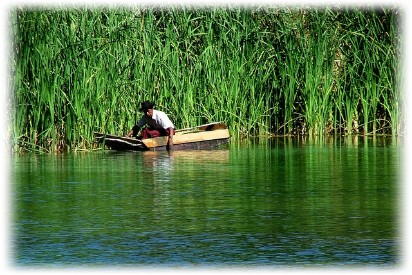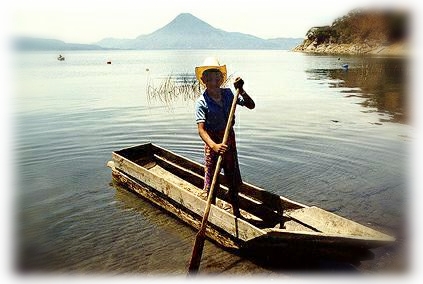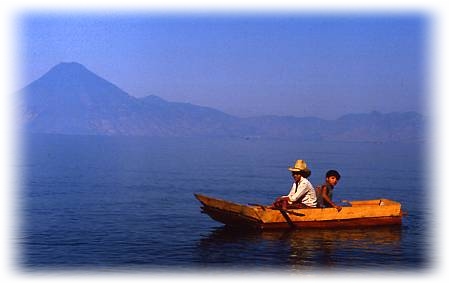Fishing in San Antonio Palopo
Fishing was and still is a common way for a man to make a living in San Antonio Palopo. The men and boys will wake up at 4:00 AM to prepare for a morning in their cayucos (canoes) out on the lake.
(The women will often wake up at 3:30 to prepare fresh tortillas for the fishermen.)
The fishermen use Cayucos which are dugout canoes made from builders in Santiago Atitlan.
Cayucos range in size, it is uncommon to see a cayuco over ten feet long or three feet wide. Due to heavy deforestation and diminishing large trees the size of the cayucos are getting smaller. A common cayuco is normally about two feet wide and seven feet long and are round on the bottoms. The tops are planked with rustic pine boards, they are frequently painted in artistic designs. Cayucos require a lot of balance and practice. Many fishermen have drowned using cayucos because of their instability. Old canoes that are falling apart and plagued with rot and holes are frequently fixed with fiberglass and polyester resin. Cayucos can last for many years and are often shared between family members. Some entrepreneurs in San Antonio Palopo rent the cayucos out to local fishermen. The cost of a small new cayuco is about 150. Dollars.
The local Maya have several methods which they use for fishing. One method is to use what the locals call “Tres Maya” which is fine net. They will set this in a designated spot and leave it overnight to trap the fish. The other method and most common is by simply holding a single fishing line with one hand hanging over the side of the cayuco and wait for the fish to grab its bait. The fishermen do not use fishing poles or reels, they simply pull the fish onto the boat by line in hand.
At the beginning of the rainy season the locals catch freshwater crabs from the lake. The fisherman will often prepare his line the night before crabbing. The fishermen will use 100 meter long line with a pieces of bait spaced out roughly a meter or two apart. They will tie one end of the line to shore, and the other end of the line will be away from shore going into deeper waters. The deep end of the line has a heavy sinker (rock) to keep it from drifting and floating soda bottle to make it visible on the water. Once they finish laying the last part of the line away from shore they will then return to shore and slowly pull up the line. When they pull the crab up close enough to the cayuco they will grab the crab with bare hands and toss it into a bucket or bottom of the cayuco. (Ask any crab fisher and they can tell you that the claws on these crabs can deliver a very painful pinch.)
On a good day a crab fisherman can catch four or five dozen crabs and earn up to 20 to 30 US Dollars from selling them in the local market. Fishermen and crab fishermen normally try to return to the shore early enough to sell their catch for lunch; normally this is around 9:00 AM.
 |  |
Recently due to many years of over fishing many fishermen have to find alternative ways of earning money.
Before 2011 there was no law or law enforcement that regulated the amount of fish caught or the size of the catch. Lake Atitlan's natural resources are running out. Just recently the population around the lake are giving notice to this problem. New laws are being made to regulate fishing in hopes to save this tradition for the future generations.
I have been fishing several times with close friends Razma and Mario Choguaj. We paddled for an hour non stop in one direction to a place which the town's municipal designated for them to fish. It was difficult to arrive at this location. We spent the morning pulling up crabs and untangling the netting used for fishing. To find only a small catch. We started our return to the shores of San Antonio Palopo at around 9:00 AM. This is about the time that the sun comes out of its shadow behind the mountain and shines down to the Lake. The locals say that as soon as the sun hits the lake the crab will no longer feed and they return to deeper waters.
The locals also like to get out of a fishing area by around 9:00 or shortly after because of (chocomil) the strong winds that come from Guatemala's Pacific coast. These winds are very consistent much of the year. The mountain sides around Lake Atitlan work much like a wind tunnel and it slams down onto the surface of the lake. This causes large waves in a very short period of time.
Waves on Lake Atitlan can get very large even though the longest fetch is only ten miles. Waves have been reported many times to reach 6 to 8 feet in height. The chop is confused from bouncing around the jagged shorelines of the lake.
" I remember one particular trip when we were on a 26 foot speed boat ( Launcha ). When we arrived to Cerro De Oro near the lake's center the waves became very dangerous. I remember a wave so high it caused a dark shadow over our boat, all I could see was the dark blue of the Lake. Fortunately our Captain and my friend Antonio steered the launcha into the wave to prevent capsize."
Each year there are at least several capsize accidents of boats ( Launchas) and often times are fatal.
In 2008 an accident made international news when a boat capsized and caused the death of. French tourist Guillermo Fresseth, Guatemalan Valerio Jowittz Cotzal the Public Ministry's assistant prosecutor and Julius Danaraj Pau a Malaysian archbishop.
